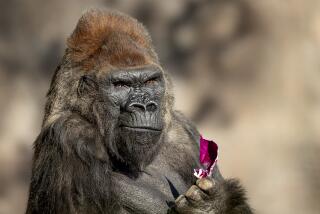Gorilla DNA offers clues about humans too
Scientists have decoded the DNA of the western lowland gorilla, a feat that could boost conservation efforts for the endangered apes as well as broaden researchers’ understanding of human origins.
The complete sequence of 20,962 genes — extracted from the skin cells of Kamilah, a 34-year-old gorilla who lives at the San Diego Zoo Safari Park — was compiled by an international team of more than 60 researchers who worked on the project for about five years.
“The gorilla genome is important because gorillas are our second-closest living relatives,” said Richard Durbin, senior author of a paper about the discovery published Wednesday in the journal Nature.
By comparing the new gorilla DNA sequence with reference genomes of humans, chimpanzees, orangutans and macaques, scientists have already made a few surprising insights into the crucial periods when we diverged into separate species.
For instance, the new genetic data bolster fossil evidence that gorillas split off as a separate species about 10 million years ago and that humans and chimps parted ways about 6 million years ago. Previous genetic evidence had seemed to point to a more recent split, prompting a contentious debate between genetics experts and fossil scholars, said Durbin, who leads the genome informatics group at the Wellcome Trust Sanger Institute in Hinxton, England.
“We’re proposing a way to make a consistent story between the genetic evidence and the fossil evidence,” Durbin said.
“That’s significant,” said University of Wisconsin anthropologist John Hawks, who was not involved in the research. “There’s an argument about early hominids — are they really our ancestors? This helps settle that. It shows it’s possible.”
The data also show that humans and gorillas differ in only 1.75% of their DNA, much less than previously believed. Humans and chimps, our closest living relatives, differ in only 1.37% of their genomes.
When Durbin and his colleagues matched up the DNA letters of gorillas, chimps and humans, they found that in 15% of cases, gorilla DNA was more like human DNA than was chimp DNA.
This result “tells us that there are individual genes for which, if you want to find the closest sequence to humans, you won’t necessarily look at chimpanzees. In a few cases, you’ll look at gorillas,” said Jeffrey Rogers, a geneticist at Baylor College of Medicine in Houston and coauthor of an editorial on the research, also published in Nature.
One of the similarities is prompting scientists to reconsider how language developed in humans. Previous studies had shown that genes involved in hearing evolved rapidly in humans. But the new study found that auditory genes evolved rapidly in gorillas too — calling into question the interpretation that the genetic changes were linked to the rise of language.
The genome researchers also identified several gene variants that cause diseases in humans, including dementia and a dangerous thickening of the heart muscle, but did not appear to be detrimental to the gorillas’ health.
“Why is that the case?” Durbin wondered. “Is there another change in the gene that compensates? Do they not use the gene the way humans do, so when it goes wrong it’s not a problem? If we understood what it was that allowed the gorilla to have the bad version that causes disease in humans, that might help us compensate for it in humans. It’s a starting point.”
To crack the genetic code of Gorilla gorilla gorilla, Durbin and his colleagues had to sort through 6 billion DNA bases — the chemical letters known as A, T, C and G that are the building blocks of our genes — and painstakingly line them up in the right order.
As part of the study, the researchers also did a preliminary genetic analysis of two other western lowland gorillas and one eastern lowland gorilla.
“Now they’re able to take sequences from a number of other gorillas and compare it to their template,” Hawks said. “You can compare individuals and say, ‘Now we understand something about the population history.’ ”
Study coauthor Oliver Ryder, director of genetics at the San Diego Zoo’s Institute for Conservation Research, said he was most interested in using the gorilla genome to study gorillas. Among other things, it will allow scientists to better understand how genetic variation within and between various gorilla species is extended across portions of Africa, aiding conservation efforts.
“Humans can pay a fee, submit a DNA sample and learn about their ancestry,” he said. “If we had that information about gorillas, management programs in zoos could utilize it to maximize preservation.”
Geneticists have already begun sequencing at least 20 more gorillas, Ryder said.







